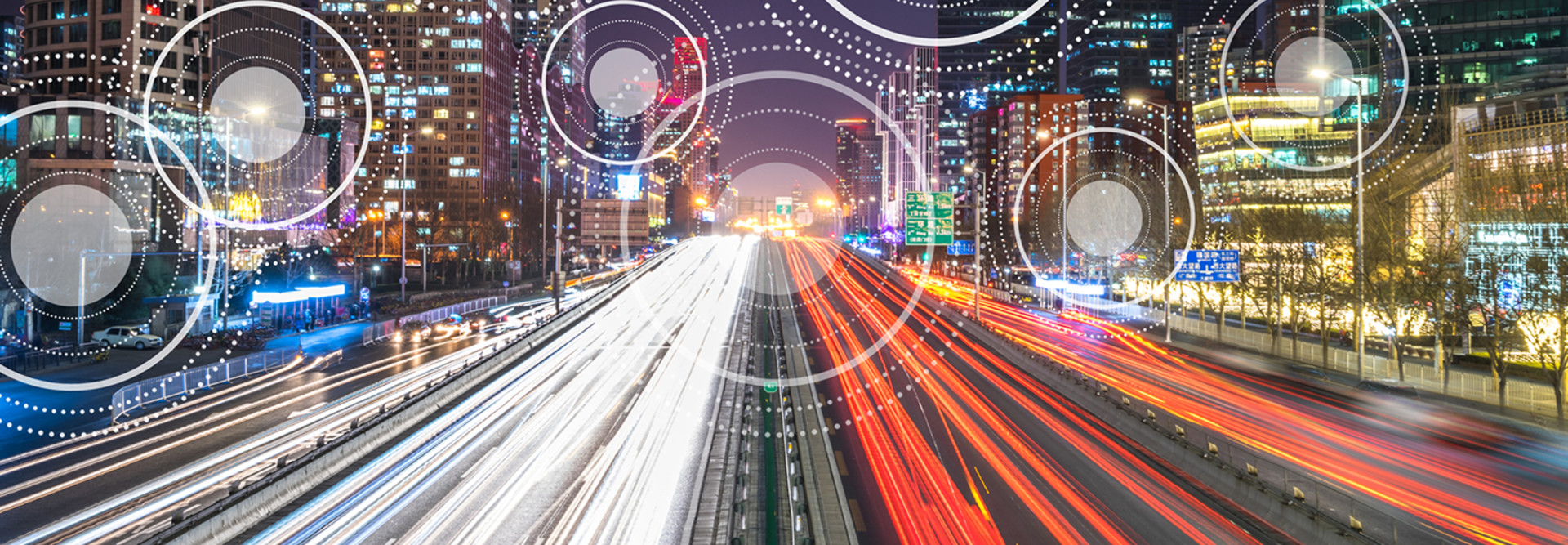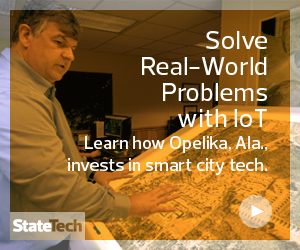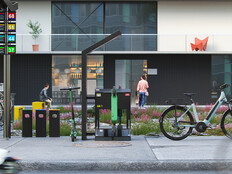1. Smart Parking Drives Efficiencies
The modern city is dominated in many ways by traffic, especially from cars. And, as cars roam city streets searching for open parking spots, they spew carbon dioxide and other tailpipe emissions, contributing to climate change.
Cities can use smart parking to make that process more efficient and environmentally friendly. Using GPS data from drivers’ smartphones and sensors embedded in the ground below parking spots, cities can determine when spots are available and deliver real-time parking maps to city residents. Mobile applications accessed via smartphones or connected car systems can send notifications to drivers if they are near an open parking spot.
For example, as StateTech has reported, Los Angeles installed smart parking technology that allows drivers to check a mobile app, website or call 511 for real-time availability and cost of parking spaces along a 4.5-mile stretch of downtown. The city also installed a dozen electronic message signs letting motorists know where to find available parking spots.
StateTech reports:
To detect whether spaces are open or occupied, the Los Angeles Department of Transportation embedded wireless sensors on 6,300 parking spaces and in some city-owned parking lots. The parking management software tabulates occupancy data and parking meter transaction data, then automatically analyzes the information, alerting transportation officials and allowing them to charge different prices based on demand, location and time of day.
Besides Los Angeles, other cities that have implemented smart parking initiatives include Ocala, Fla.; Norwalk, Conn.; and the San Francisco suburbs of Redwood City and San Mateo.
MORE FROM STATETECH: Find out why these eight smart cities are ones to watch!
2. Smart Streetlights Make Cities Safer — and Save Money
For cities looking to tap the Internet of Things, smart streetlight upgrades can give them a strong foundation.
Cities can refurbish old streetlights with more energy-efficient LED bulbs, as well as wireless connectivity, motion sensors that activate lights when passersby are near and connected sensors that can alert the city when bulbs need to be changed.
Those solutions can help make streets safer, all while saving governments a great deal of money on electricity costs. Chicago reported in August that, a year into a four-year streetlight modernization program, it had installed more than 76,000 LED streetlights in the city’s violence-prone south and west sides. By switching to energy-efficient LED streetlights, the city expects to cut its streetlight electricity costs in half, a savings officials estimate at approximately $100 million over 10 years.
Meanwhile, StateTech reports:
Los Angeles, an early adopter of the tech, has equipped more than 80 percent of its streets with connected lights that feature LED bulbs and 4G LTE wireless connectivity over the last few years. The city is already seeing the benefits of the change. The city reported a 63 percent savings on its energy bill in the first year with the new lights, and it’s using the connected poles to improve resident cell service, among other benefits.
And, as Information Age observes, this data collected by sensors supported by street lights cuts to the heart of the smart cities idea. Connected cities make use of real-time information provided by sensors, networks and data analytics, and street lights are a fundamental piece of infrastructure providing statistics on how well the city is doing.
3. Smart Transportation Increases Pedestrian and Driver Safety
Smart transportation systems are a catchall that includes everything from driverless cars to smart traffic signals. Through sensors, analysis and communication among systems, intelligent transportation systems aim “to ease congestion, improve traffic management, minimize environmental impact and increase the benefits of transportation to commercial users and the public in general,” notes TechTarget.
Columbus, Ohio, has become somewhat synonymous with the idea of a smart city — and smart transportation — since about two years ago, when it won a $40 million grant through the highly publicized Smart City Challenge, a nationwide contest put on by the U.S. Transportation Department. The city is not just focused on autonomous vehicles, but also supports a multimode trip-planning application to help residents use different mobility options in and around the city, enhanced by a common payment system.
Meanwhile, many other cities are using connected traffic lights and cameras at traffic signals to improve pedestrian safety. For example, Boston’s Smart Streets project involved a partnership with Verizon to test data gathering technology at the intersection of Massachusetts Avenue and Beacon Street, where a cyclist was killed during a traffic incident. The city used video cameras; LED lights; under-road sensors; and a web-based platform for data analysis, dashboards, visualization and reporting. The goal was to gather aggregated data about traffic patterns at the intersection. The city tweaked roadway design and signal timing to improve safety.
And Portland, Ore., has deployed 192 sensors on three of its dangerous streets. The sensors, which were installed on light poles, will provide a constant count of vehicles and pedestrians as well as data about vehicle speeds. The sensors include two cameras, “an array of environmental sensors for measuring temperature, pressure and humidity, a CPU/GPU for performing real-time analytics, a solid-state drive for local data storage, and cellular LTE hardware for data transmission.”
Using the data collected by the sensors, the Portland Bureau of Transportation’s staff “will use the sensor information to make recommendations about future changes” to make it easier for pedestrians to walk and cars to drive on these and other city streets, the city says on the project website.
4. Smart Energy Enables Other Smart City Solutions
According to the nonprofit Smart Energy Consumer Collaborative, modernizing electric grids through smart grid enhancements “is an integral first step to enabling smart cities.” Making renewables like rooftop solar power more realistic is “a game changer for sustainability,” and increasing their use can enhance public health and improve the environment.
Smart grid enhancements also “allow better integration of new technology like electric vehicles, which, in turn, creates a bevy of possibilities down the road for urban areas,” the group notes. “Future possibilities would include city-wide zero-emissions transportation and electric vehicles that act as power storage in case of emergencies.”
Smart grids also allow residents to access their energy data and enables utilities to offer new pricing programs that can lead to increased energy efficiency, the nonprofit says.
MORE FROM STATETECH: Get caught up on the key takeaways from the Smart Cities Week 2018 conference!
5. Smart Health Gets a Boost in Smart Cities
Smart cities are often driven by increased connectivity. Those networks help enable sensors that collect and transmit data and, eventually, can improve city services. However, that connectivity can also help improve residents’ health.
In Chattanooga, Tenn., the Electric Power Board of Chattanooga, the city’s municipally owned telecom and utilities provider, has invested heavily in fiber-optic network infrastructure, delivering 1-gigabit-per-second connections. That has enabled residents to access superfast broadband services, but it could also spur the deployment of new services, including telehealth.
The city is actively exploring the idea of delivering telehealth services to residents who subscribe to EPB broadband services. With EPB closing in on 100,000 total subscribers, telehealth services could potentially benefit a significant number of residents.
There are other ways that public health can be enhanced in smart cities. About a year ago, Sidewalk Labs, the smart city arm of Google’s parent company, Alphabet, spun out the aptly-named public health unit, Cityblock Health. The company aims to leverage technology alongside new care models to provide for underserved populations and level the healthcare playing field.
“Our idea is simple: cities should be healthy places to live — for everyone,” Iyah Romm, co-founder and CEO of Cityblock Health, wrote in a blog post announcing the new company. “To make cities healthy, we need a system in which value is rewarded over volume, provider-patient relationships are meaningful and lasting, and the use of technology decreases costs instead of raising them.”
As a way to bring telehealth and other health technologies to all city residents, not just the affluent, Cityblock has developed a platform called Commons. The tool allows a care team to wrap itself around a patient and connect, according to MobiHealthNews.
“Part of the notion here is that technology has to stitch this ecosystem together,” Romm said in October at the Connected Health Conference in Boston, according to MobiHealthNews. “The notion that health is local and pervades everything we all talk about across why these models don’t scale. So as opposed to running away from that and saying ‘it’s impossible,’ we’ve embraced it. We said, ‘How do we build a tech platform that adapts to locality?’”
6. Smart Buildings Help Protect the Environment
According to Navigant Research, around of 30 percent global greenhouse gas emissions and 70 percent of energy consumption in major cities are attributable to buildings. Sensors in smart buildings can detect when there are people in a room so that temperature and lighting can be adjusted, saving money and sparing the environment, when rooms are not in use.
“Thus, buildings can play a pivotal role in helping to achieve smart city goals,” Navigant says. “The data collected and insights generated by smart building technologies can lead to changes in facilities management that reduce energy consumption for climate and sustainability goals and help improve public health and safety.”
Industrial giant Siemens notes that “the world’s most advanced buildings have brains — a kind of central nervous system that balances and reconciles competing interests such as energy minimization, occupant comfort, and grid stability.”
Like other industrial companies and network technology vendors, Siemens has a building automation system. Known as Desigo CC, it allows all building systems to be integrated into a single platform that can be operated intuitively. Such systems can allow fire protection, heat, ventilation and climate control, lighting and video surveillance to be managed together.
7. A Smart Environment Is Necessary in Smart Cities
As cities add more “green” buildings that are energy efficient, they should also be thinking of how technology can improve the environment more broadly.
The consultancy Deloitte says that for a smart city to live up to its name, “using technology to foster sustainable growth is essential.”
“This means leveraging technology to maximize the efficient use of precious resources and encourage sound choices by all players,” Deloitte adds. “This includes not only city-owned buildings, but businesses, universities, hospitals and nonprofits and individual citizens. This means likely leveraging sensor technology, behavioral economics, and gamification to alter not only physical infrastructure, but to encourage positive resourcing decisions.”
That applies to everything from sensors to detect water leaks, just-in-time waste collection and energy distribution. It can also apply to how cities are constructed. Sidewalk Labs’ planned design of Toronto’s Eastern Waterfront district will include timber buildings.








.jpg)



